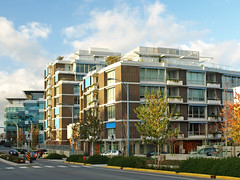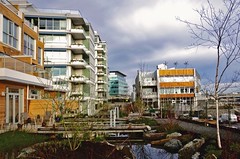Canada Green Building Council acquires smart growth organization, vows to advocate smart growth nationally

Posted June 2, 2010 at 1:33PM
Canada’s leading green building organization and one of its leading smart growth organizations have decided to combine into one corporate entity. More specifically, Smart Growth BC, based in Vancouver, has announced that “its programs and brand have been acquired by” the Canada Green Building Council (CaGBC).
In a press release dated May 5, Smart Growth BC said that the announcement “heralds the beginning of a national approach to supporting a Smart Growth Canada Program.” CaGBC intends to establish a steering committee to guide the delivery of a national program to promote a range of green building and community development tools applicable at the scale of an entire city, region, neighborhood or smaller community, as well as the individual building. (CaGBC’s press release is here.)
CaGBC administers Canada’s version of the LEED (Leadership in Energy and Environmental Design) green building rating system, and plans to administer a version of LEED for Neighborhood Development starting in early 2011. Twenty-three Canadian projects already have been participating in the LEED-ND pilot program created by NRDC, the US Green Building Council and the Congress for the New Urbanism; eight have been certified to date, including three in British Columbia. Victoria’s Dockside Green and Vancouver’s Olympic Village, both certified platinum, are among the very highest-rated projects in the pilot program.
I find this intriguing for a number of reasons:
- It is heartening to see a close joining of smart growth advocacy and green building advocacy. In the US the two have been pursued separately and, even within NRDC, are placed in separate parts of the organization. Although in my opinion it is a shame, green building certifications and awards are given with little attention to whether the projects also are congruent with smart growth, and smart growth endorsements and awards are given with little attention to whether the projects contain green building features. LEED-ND is the only major effort so far in which the two movements have aligned in a cohesive way.
- It is rare, at least in the US, for one environmental nonprofit to acquire another.
- In both the US and Canada, the Green Building Council is largely an industry-driven body. The USGBC even requires that certain industry sectors be represented on its board and some of its governing committees. But the smart growth movement’s base, at least in the US, is largely driven by grassroots activists, nonprofit advocacy organizations, and progressive architects and planners. There are lots of partnerships with the building and development industry, to be sure, but the bases of the two movements are distinct. It would be a challenge to merge the two without one or the other suffering somewhat.
This will be interesting to follow. My hope is that both causes become stronger as a result.
 Smart Growth BC was created as a joint project of the University of Victoria Eco-Research Chair of Environmental Law and Policy and West Coast Environmental Law Association. The project aimed to nurture and mobilize a growing citizen movement addressing growth and sprawl issues around the province, and to provide sound alternative policy solutions to these issues. The organization has worked with community groups, businesses, developers, planners, municipalities and the public to create more livable communities in British Columbia. The organization was incorporated as an independent, non-profit society in December 1999.
Smart Growth BC was created as a joint project of the University of Victoria Eco-Research Chair of Environmental Law and Policy and West Coast Environmental Law Association. The project aimed to nurture and mobilize a growing citizen movement addressing growth and sprawl issues around the province, and to provide sound alternative policy solutions to these issues. The organization has worked with community groups, businesses, developers, planners, municipalities and the public to create more livable communities in British Columbia. The organization was incorporated as an independent, non-profit society in December 1999.
CaGBC has worked since 2002 to promote high-performing, healthy green buildings, homes and communities nationwide through standards, best practices, advocacy and education. The organization, with offices in Ottawa and Vancouver, has over 2300 corporate members and eight chapters across the country.
Move your cursor over the images for credit information.

